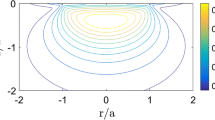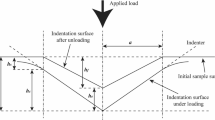Abstract
In this work, nano, micro, and macro-indentation tests under standard or multicycle loading conditions were performed for studying the mechanical behavior of a crown borosilicate glass sample with the objective to study the scale effect in indentation and the influence of cracks formation on the assessment of mechanical properties. When no cracks were initiated during the indenter penetration, especially for low indentation loads, the mechanical properties were deduced by applying different methodologies, (i) Standard (or monocyclic) loading, (ii) Continuous Stiffness Measurement mode, (iii) Constant and progressive multicycle loading, and (iv) Dynamic hardness computation. It has been found independently of the loading conditions, Martens hardness and elastic modulus are approximately 3.3 and 70 GPa, respectively. However, when cracking and chipping are produced during the indentation test, two damage parameters related to hardness and elastic modulus can be used for representing the decrease of the mechanical properties as a function of the relative penetration depth.











Similar content being viewed by others
References
B. Balland: Optique géométrique: Imagerie et instruments (Geometrical Optics: Imaging and Instruments) (PPUR Presses Polytechniques, Lausanne, 2007); p. 860.
J. Phalippou: Verres: Propriétés et applications (Glasses: Properties and Applications), Techniques de l’ingénieur AF3601, July 10, 2001.
G.F. VanderVoort: Metallography: Principles and Practice (McGraw-Hill, New York, 1984); p. 752.
W.I. Rupp: Loose abrasive grinding of optical surface. Appl. Opt. 11(12), 2797–2810 (1972).
A.A. Tesar and B.A. Fuchs: Removal rates of fused silica with cerium oxide and pitch polishing. Proc. Soc. Photo-Opt. Instr. Eng., 1531, 80–90 (1992).
H.H. Karow: Fabrication Methods for Precision Optics (Wiley-Interscience, Hoboken, 2004); p. 768.
E. Brinksmeier, O. Riemer, and A. Gessenharter: Finishing of structured surfaces by abrasive polishing. Precis. Eng. 30(3), 325–336 (2006).
H.H. Pollicove and D.T. Moore: Optics manufacturing technology moves toward automation. Laser Focus World 27, 145–149 (1991).
D. Golini and W. Czajkowski: Micro grinding makes ultra-smooth optics fast. Laser Focus World 28, 146–152 (1992).
D. Golini: Influence of process parameters in deterministic micro-grinding. OSA 13, 28–31 (1994).
H.H. Pollicove: Computer aided optics manufacturing. Opt. Photonics News 6, 15–19 (1994).
R.L. Aghan and L.E. Samuels: Mechanisms of abrasive polishing. Wear 16(4), 293–301 (1970).
Y. Xie and B. Bushan: Effects of particle size, polishing pad and contact pressure in free abrasive polishing. Wear 200(1–2), 281–295 (1996).
J.C. Lambropoulos, S. Xu, and T. Fang: Loose abrasive lapping hardness of optical glasses and its interpretation. Appl. Opt. 36(7), 1501–1516 (1997).
T. Suratwala, P. Davis, L. Wong, P. Miller, M. Feit, J. Menapace, and R. Steele: Sub-surface mechanical damage distributions during grinding of fused silica. J. Non-Cryst. Solids 352(52–54), 5601–5617 (2006).
A. Esmaeilzare, A. Rahimi, and S.M. Rezaei: Investigation of subsurface damage and surface roughness in grinding process of Zerodur glass-ceramic. App. Surf. Sci. 313, 67–75 (2014).
C. Anunmana, K.J. Ausavice, and J.J. Mecholsky, Jr: Residual stress in glass: Indentation crack and fractography approaches. Dental Mater. 25, 1453–1458 (2009).
R. Komanduri, D.A. Lucca, and Y. Tani: Technological advances in fine abrasive processes. Annals of the CIRP 46(2), 545–596 (1997).
S.D. Jacobs, S.R. Arrasmith, I.A. Kozhinova, L.L. Gregg, A.B. Shorey, H.J. Romanofsky, D. Golini, W.I. Kordonski, P. Dumas, and S. Hogan: MRF: Computer-controlled optics manufacturing. Am. Ceram. Soc. Bull. 78, 42–48 (1999).
J.P. Marioge: Surface optique: Méthodes de fabrication et de contrôle, recherches (Optical Surface: Production and Control Methods, Researches) (EDP Sciences France, Les Ulis, 2000); pp. 26–33.
W. Oliver and G. Pharr: An improved technique for determining hardness and elastic modulus using load and displacement sensing indentation experiments. J. Mater. Res. 7(6), 1564–1583 (1982).
J.M. Antunes, L.F. Menezes, and J.V. Fernandes: Three-dimensional numerical simulation of Vickers indentation tests. Int. J. Sol. Struct. 43(13–4), 784–806 (2006).
J.T.R. Field and R.H. Telling: The Elastic Modulus and Poisson Ratio of Diamond, Research Note (Cavendish Laboratory, Cambridge, 1999).
D. Chicot, M. Yetna N’Jock, E.S. Puchi-Cabrera, A. Iost, M.H. Staia, G. Louis, G. Bouscarrat, and R. Aumaitre: A contact area function for Berkovich nanoindentation: Application to hardness determination of a TiHfCN thin film. Thin Solid Films 558(2), 259–266 (2014).
J.M. Antunes, A. Cavaleiro, L.F. Menezes, M.I. Simoes, and J.V. Fernandes: Ultra-microhardness testing procedure with Vickers indenter. Surf. Coat. Technol. 149, 27–35 (2002).
L.A. Berla, A.M. Allen, S.M. Han, and W.D. Nix: A physically based model for indenter tip shape calibration for nanoindentation. J. Mater. Res. 25, 735–745 (2010).
D. Chicot, P. De Baets, M. Staia, E. Puchi-Cabrera, G. Louis, Y.P. Delgado, and J. Vleugels: Influence of tip defect and indenter shape on the mechanical properties determination by indentation of a TiB2–60% B4C ceramic composite. Int. J. Refract. Met. Hard Mater. 38, 102–110 (2013).
M. Troyon and L. Huang: Correction factor for contact area in nanoindentation measurements. J. Mater. Res. 20, 610–617 (2005).
M.Y. N’jock, D. Chicot, J. Ndjaka, J. Lesage, X. Decoopman, F. Roudet, and A. Mejias: A criterion to identify sinking-in and piling-up in indentation of materials. Int. J. Mech. Sci. 90, 145–150 (2015).
D. Chicot and D. Mercier: Improvement in depth-sensing indentation to calculate the universal hardness on the entire loading curve. Mech. Mater. 40(4–5), 171–182 (2008).
J. Lemaitre and J. Dufailly: Damage measurements. Eng. Fract. Mech. 28, 643–661 (1987).
J. Malzbender, J.M.J. den Toonder, A.R. Balkenende, and G. de With: Measuring mechanical properties of coatings: A methodology applied to nano-particle fille sol-gel coatings on glass. Mater. Sci. Eng., R 36, 47–103 (2002).
R.F. Cook and G.M. Pharr: Direct observation and analysis of indentation cracking in glasses and ceramics. J. Am. Ceram. Soc. 73, 787–817 (1990).
Author information
Authors and Affiliations
Corresponding author
Rights and permissions
About this article
Cite this article
Bentoumi, M., Bouzid, D., Benzaama, H. et al. Multiscale and multicycle instrumented indentation to determine mechanical properties: Application to the BK7 crown borosilicate. Journal of Materials Research 32, 1444–1455 (2017). https://doi.org/10.1557/jmr.2016.523
Received:
Accepted:
Published:
Issue Date:
DOI: https://doi.org/10.1557/jmr.2016.523




